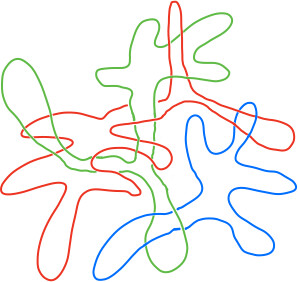Current theories on the conformation and dynamics of unknotted and non-concatenated ring polymers in melt conditions describe each ring as a tree-like double-folded object. While evidence from simulations supports this picture on a single ring level, other works show pairs of rings also thread each other – a feature overlooked in the tree theories. Here we reconcile this dichotomy using Monte-Carlo simulations of the ring melts with different bending rigidity. We find that rings are double-folded (more strongly for stiffer rings) on and above the entanglement length scale, while the threadings are localized on smaller scales. The different theories disagree on the details of the tree structure, i.e the fractal dimension of the backbone of the tree. In the stiffer melts we find an indication of a self-avoiding scaling of the backbone, while more flexible chains do not exhibit such a regime. Moreover, the theories commonly neglect threadings, and assign different importance to the impact of the progressive constraint release (tube dilation) on single ring relaxation due to the motion of other rings. Despite each threading creates only a small opening in the double-folded structure, the threading loops can be numerous and their length can exceed substantially the entanglement scale. We link the threading constraints to the divergence of the relaxation time of a ring, if the tube dilation is hindered by pinning a fraction of other rings in space. Current theories do not predict such divergence and predict faster than measured diffusion of rings, pointing at the relevance of the threading constraints in unpinned systems as well. Revision of the theories with explicit threading constraints might elucidate the validity of the conjectured existence of topological glass.
Download “Article” separate_threading_from_branching.pdf – Downloaded 341 times – 4 MB
Download a copy of the manuscript

